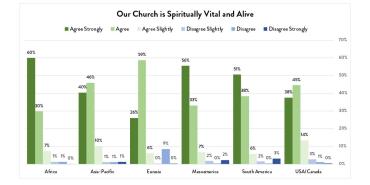Peace Be With You

Friends talk about our ever-changing world and our roles as Christians in it: They call attention to daily news headlines reminding us that winds of change blow continually across the globe. They speak of the developing picture of national leaders and shifts in governments around the world. They remind me of the advancements in science and technology that bring innovation at break-neck speed.
Then they ask, “What does it mean to be the church in this new world?”
My answer to that question looks across 1,000 years to the days of the Holy Roman Empire in the west, then 2,000 years to the New Testament era, then 3,000 years to the reign of King David, and then 4,000 years to the adventures of Abraham. Each generation of human history has experienced its own array of opportunities and challenges. When we plant our feet in the soil of each time span, we see that people lived in seasons of change and sensed an air of uncertainty about the future.
However, the basic needs of human beings have changed very little across the years of human existence. People always need clean air to breathe, safe food to eat, pure water to drink, and a dwelling place to protect them from nature’s elements. The basic needs of human hearts have changed very little across the years as well.
Members of the Christian church live and proclaim a message and a lifestyle that addresses the needs of human hearts.
So, living and ministering as disciples of Jesus Christ in our new world have common characteristics to the ways disciples have lived and ministered throughout church history. Jesus demonstrated a worthy model when He encountered the woman at the Samaritan well (John 4:4-24).
- He entered into conversation with this woman who happened to be a social outcast due to her lifestyle choices.
- He put her need to hear the good news ahead of the social etiquette of His day, which restricted conversation between Jews and Samaritans.
- He quickly made the connection between well water, which met a basic physical need, and spiritual water, which spoke to the need of the woman’s heart.
His actions remind us that our physical world is filled with signposts that point us to life’s spiritual realities and ultimately to God and to the peace only He can supply.
As the conversation progressed, Jesus refused to allow the woman to shift topics to pointless religious chatter. He kept the conversation focused on the Father and her need for a relationship with Him. Jesus then promised, “I will give you living water” (John 4:10). Of course, Jesus was using living water as an analogy of the Holy Spirit who flows through our lives. This living water of the Spirit keeps our spiritual lives fresh every day. It makes us fruitful like a river flowing through an arid desert. The Spirit’s living water quenches our spiritual thirst for God and at the same time makes us thirsty for more of His presence and peace in our lives.
The Samaritan woman became so thirsty for this living water that she accepted Jesus’ offer and felt her deepest need met. The overflowing fullness of her heart compelled her to tell everyone she knew about her newfound relationship with God. She was forever changed because Jesus encountered her.
That’s what it means to be the church in today’s world. We are the hands and feet of Jesus for our generation. Of course we’re living in ever-changing, uncertain days. No news flash there; life on earth experiences constant change. But, people still thirst for water, and they still thirst for a relationship with God. We have an opportunity to minister to friends, family, and even strangers just as Jesus did. The peace Christ offered then is still available today.
We can share the Father’s living water that will satisfy their deepest thirst even as they live in our ever-changing world. In our service to Christ, let us offer peace in the midst of the world’s fear and confusion. We can offer hope where hopelessness prevails. Let’s be the hands and feet of Jesus to those who need Him today.
Peace be with you.
Frank M. Moore is Editor in Chief of Holiness Today
Holiness Today, Jan/Feb 2017
Please note: This article was originally published in 2017. All facts, figures, and titles were accurate to the best of our knowledge at that time but may have since changed.




